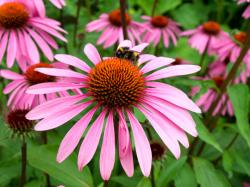Newest Varieties Of Coneflowers Represent The Rainbow
July 15, 2011 | 2 min to read

Echinacea, or coneflower as they are commonly known, are striking perennials that provide colorful flowers from late June into fall. A native of North America, "Echinacea" is found in open woodlands and across the prairies. A sun-loving perennial plant, coneflower produces saturated colorful flowers that have a distinctive cone on sturdy stems. This prickly, spiky central cone of the flower is the reason the genus Echinacea was named after the Greek word echinos, which means hedgehog or sea urchin.
Echinacea purpurea is the common species of Echinacea that is used in cosmetics, teas and herbal applications. Recent hybridizing by plant breeders has greatly expanded the purple and pink palette of colors, sizes and flower attributes available. New selections on the market and in local garden stores include fun names like "Tomato Soup" – a true red flower; "Mac-n-Cheese" – a creamy yellow; "Tiki Torch" – a pumpkin orange; "Coconut Lime" – a double creamy white flower with lime green center; "Firebird" – a red-orange; "Red Knee High" – a dwarf red; "Hot Papaya" – a red-orange; and "Irresistible" – double salmon-orange.
"Coneflower" has a variety of landscape uses. It makes a great cut flower lasting several days after being cut. It is also wonderful to attract butterflies and is a good pollinator conservation plant for bees. I like to use Echinacea in my mixed container plantings with annual flowers and ornamental grasses. In the landscape, I like to plant coneflower in groups of 3, 5, 7 or more to really make an impact. A single plant is not near as striking as planting in mass.
To read the rest of the story, please go to: Knoxville News Sentinel
